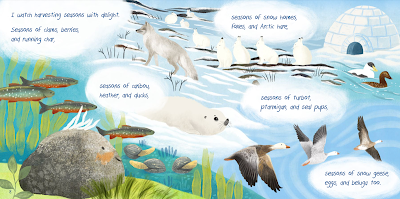Drawings by Kelly Collier
Owlkids Books
978-1-77147-497-9
80 pp.
Ages 6-8
April 2024
Like the classic early readers about Frog and Toad, Otis and Peanut have many stories to tell. The unlikely friendship of the long-haired guinea pig (Otis) and the naked mole rat (Peanut) is fodder for three more stories in Otis & Peanut: Forever and Ever that cover everything from cake to memories, gardening and absent sisters.
In the story titled "The Cake," Peanut surprises Otis with a luscious three-layer strawberry cake based on his sister Pearl's recipe. Though Peanut wants to dig in, Otis wonders what they are celebrating. Apparently, Peanut's answer of "celebrating cake with cake" doesn't cut it and is determined to save it for a special occasion. But would there ever be a good enough reason to eat cake?
 |
| From Otis & Peanut: Forever and Ever, written by Naseem Hrab, illustrated by Kelly Collier |
"The Collection" is Naseem Hrab's final story for Otis & Peanut: Forever and Ever, and says more about memories than the earlier chapters. While Peanut grieves the loss of his sister Pearl and finds himself remembering her in everything from baking to eating and playing, it is Otis who helps him to see the value in keeping memories as tangible objects. Otis himself keeps scrapbooks of memories and demonstrates to Peanut that, no matter how important the memories are, sometimes you can forget them. So, Peanut finds a way to keep his own memories, both happy and sad, safe and make new memories with his friend.
 |
| From Otis & Peanut: Forever and Ever, written by Naseem Hrab, illustrated by Kelly Collier |
Kelly Collier, who illustrated the first Otis & Peanut book, uses the same colour palette of turquoise and chartreuse with splashes of pink as she did in the first. It works to keep the overall effect uncomplicated but focused. Whether it's the cake or the jam and the garden or the keeping of memories, one emphasis is evident and not the background of detailed characters and settings or the jibber jabber of extraneous text. Together Kelly Collier and Naseem Hrab remember who their audience is and ensure that their reading and storytelling needs are met.
Because children have so much happening in their lives, whether it's a daily occurrence like picking clothes or reading books, or special events like a birthday party or performing at a recital, there are loads of stories that Naseem Hrab and Kelly Collier can share through Otis and Peanut. Whether it's to teach them about being a good friend, or to reflect the young lives of these readers, Otis and Peanut are there, as are we, to watch and learn.
Otis & Peanut (2023)
Otis & Peanut: Forever and Ever (2024)



















































